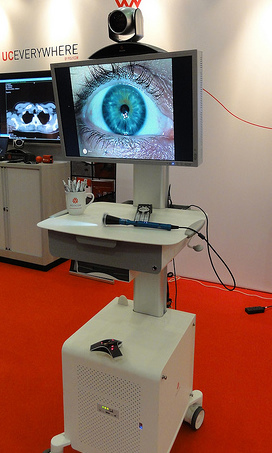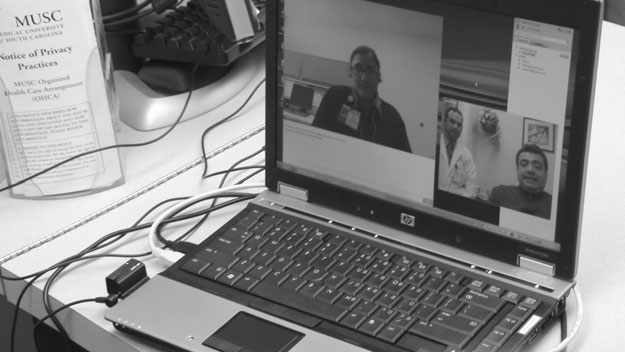 While videoconferencing carts (H.323 standard definition) are supposed to be portable and easy to use, this isn’t necessarily the case. It becomes quite an inconvenience if the unit regularly needs to be set up in a room that is off its network, like the interpretation office of this study. The complaint was that these units “took time to set up and…used up space,” causing NIH and Medical University of South Carolina (Charleston) researchers to look for a more mobile and convenient videoconferencing solution.
While videoconferencing carts (H.323 standard definition) are supposed to be portable and easy to use, this isn’t necessarily the case. It becomes quite an inconvenience if the unit regularly needs to be set up in a room that is off its network, like the interpretation office of this study. The complaint was that these units “took time to set up and…used up space,” causing NIH and Medical University of South Carolina (Charleston) researchers to look for a more mobile and convenient videoconferencing solution.
VSee Video Chat – The Ideal Telemedicine Solution
After testing various systems and setups for the experiment, the researchers eventually settled on using laptops on a 3G wireless network with additional Point-Tilt-Zoom (PTZ) cameras, and VSee for videoconferencingsoftware. It turns out that VSee was an ideal candidate for this experiment:
- It’s great for cellular networks since it delivers data at rates as low as 50 Kbps for video and 16 Kbps for audio. (H.323 standard videoconferencing software requires 384 Kpbs for acceptable video quality).
- It allows for remote control of PTZ cameras which medical providers like to have.
- It helps protect patient privacy since it provides secure Federal Information Processing Standards (FIPS) 140-2 256 bit Advanced Encryption Standard (AES)-encrypted video transmission.
- Its video quality is superior to other low-bandwidth videoconferencing products.
- Its default window of 240 x 320 pixels can be expanded up to HD 720 pixels as needed.

Figure from Locatis, et al (2011)
The Experimental Situation – Medical Interpretation in a real Pharmacy
The test case was a South Carolina pharmacy with a fast-growing Spanish-speaking population and a lack of interpretation services. For the experiment, the pharmacy set up a private consulting room and scheduled a clinic one morning a week during which non-English speakers would receive interpretation services via phone or laptop videoconference through the research hospital’s interpreters. The study included data from 26 patients, 2 pharmacists, 1 bilingual registered nurse, and 5 interpreters. Half the patients received interpretation services by phone and half received services by video.
Success with VSee Low-bandwidth Videoconference
Videoconferencing with VSee over 3G works great! In particular, I’m happy to report that providers had few technical issues and were all impressed with the quality of VSee video over a cellular network. The setup provided comparable experimental results from previous medical interpretation studies using H.323 standard definition videoconferencing units:
- Patients were happy to get interpretation services through any available means (phone or video).
- Providers, on the other hand, still preferred being able to talk with patients face-to-face first, then by videoconference, and last by phone. Also, while there was some disagreement about whether video actually made the consultation better, none of the providers felt that phone-only consultations were better.
- Unexpectedly, video was more useful in letting pharmacists know when interpreters were having trouble with a medicine’s name or an explanation.
- PTZ cameras, while essential in settings where the patient moved around, turned out to be unnecessary in the pharmacy setting where patients are stationary the whole time.
- In follow up tests, VSee video proved to be large enough and smooth enough for sign language interpretation as well.
Issues and Concerns
In the end, the main concern with using cellular networks is that while 3G and 4G cell networks provide enough bandwidth for videoconferencing, the signals can be easily affected by network congestion, interference, and other factors not necessarily in your control. To minimize these issues, the study advises initially testing signal reception from the actual location(s) to be used, obtaining necessary bandwidth amplification equipment, and constantly monitoring network traffic.
Telemedicine units using traditional videoconferencing hardware can run to the tens of thousands of dollars and require massive infrastructure to set up, which many hospitals and clinics may not be able to afford. This feasibility study shows that with a laptop, 3G cellular network, and the right videoconferencing solution (like VSee) it’s possible to make healthcare more affordable and more accessible than ever before.
References
Craig Locatis, Deborah Williamson, James Sterrett, Isabel Detzler, and Michael Ackerman. (2011). Video medical interpretation over 3G cellular networks: A feasibility study. Telemedicine and e-Health, 17(10): 1-5.
Follow us on Twitter (@VSee) and Like us on Facebook to hear about the latest from VSee!
top photo by Andy G



